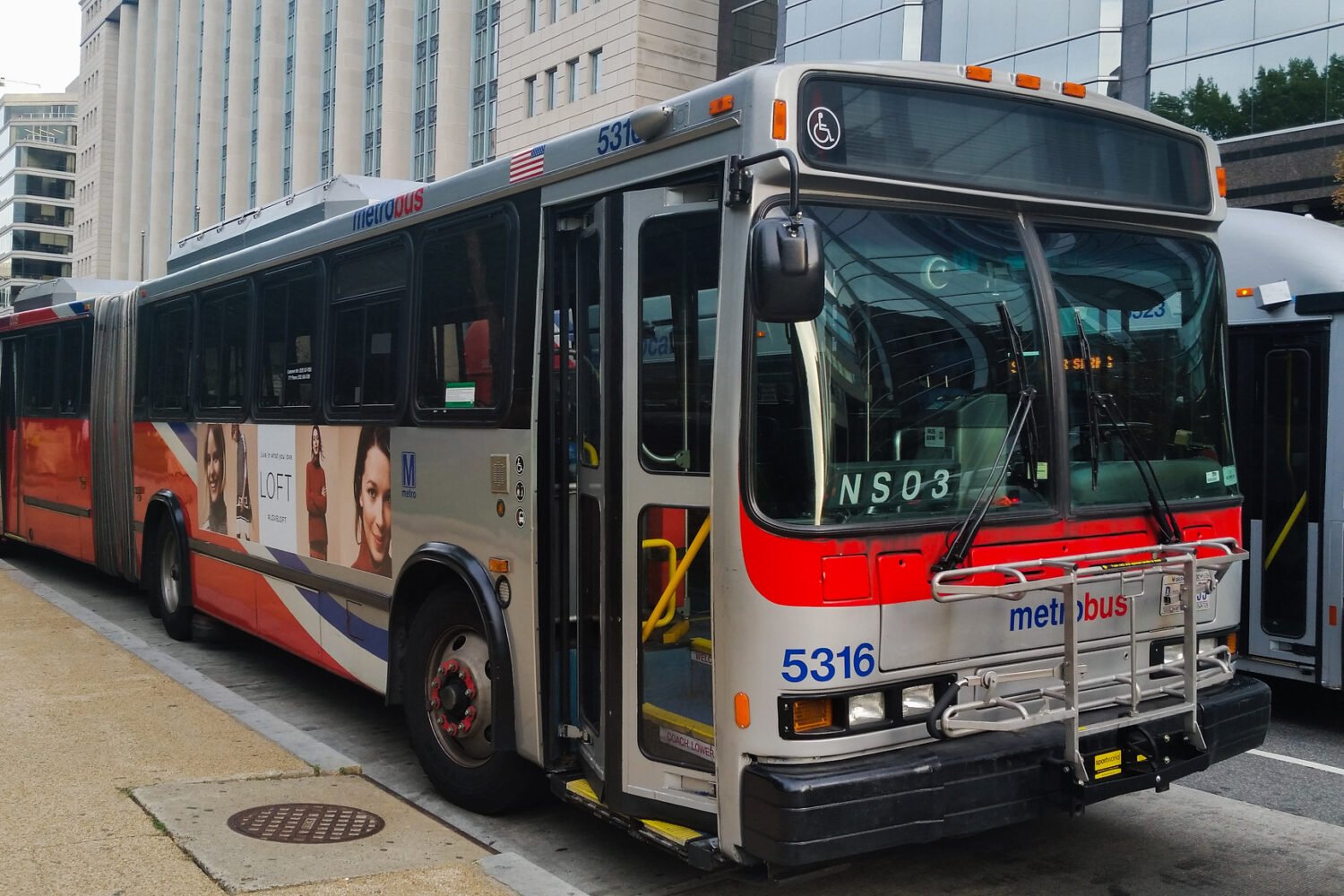The other day, I got on the 70 Metrobus at Georgia Avenue and Kennedy Street, Northwest, by my aunt’s old (now shuttered) Caribbean restaurant. I was the last person to board after five people loaded their SmarTrip cards at the fare box, and as the bus rumbled to life, I squeezed in next to the door. Slowly, I made my way toward the back, past people with grocery carts and strollers and bikes and shopping bags. Music wafted from somebody’s earbud-free iPhone, but it competed with dozens of boisterous conversations about the news, weekend plans, and of course, the stifling heat.
I steadied myself through the bendy accordion section, which seemed to move independently of everything else. As we hit the light at Missouri Avenue, I slipped, caught myself, and eyed an open seat. I plunked down just as the bus stopped in front of Walmart. An older gentleman in a Skins jersey pounded on the plexiglass, yelling, “Back door!” People streamed out of the three doors, but there was already a line 12 people deep on the sidewalk.
Did I mention that this wasn’t at rush hour but at 2:30 on a Saturday afternoon?
In a furiously changing Washington, the 70 bus—and its siblings, the 74 and 79—might be the one constant: polyglot, crowded, and full of so many characters that there’s actually a play about it. This ten-mile route shoots up Seventh Street and Georgia Avenue, through a dense swath of neighborhoods that represent seemingly every race and socioeconomic class in Washington.
The south end of the route is the 74 bus. Starting near Nationals Park, it crosses the Mall, where the 70 and 79 take over. Then it heads past the Verizon Center and the crowds of Chinatown, past gentrified Shaw’s trendy beer gardens and faux dive bars, past Howard University’s gigantic parking lots, past Petworth’s newly refurbished rowhouses, and up through the real dive bars and takeout joints in Brightwood and Shepherd Park before landing at the Silver Spring Metro station. It connects to nine Metro stops on all six lines, not to mention dozens of other bus routes.
All of those destinations, of course, mean more reasons to take this route—unlike other, commuter-focused ones, which are designed to carry people downtown in the morning and back home in the afternoon. In fact, the District Department of Transportation found that the 70 buses don’t really have a busiest stop. Riders are using them to go within the city, not simply in and out.
The 70s manage to do all of this more or less in a straight shot, making it easy for riders to figure out where to catch the bus without carrying a map or remembering lots of twists and turns. Just walk out to Seventh or Georgia, and chances are there’s a stop at the corner. The 70s run 24 hours a day, seven days a week, as often as every seven minutes during rush hour, every 15 minutes the rest of the day.
These are all reasons why the 70 is Metro’s most popular bus line. Collectively, the 70s carried an average of 20,000 passengers per weekday last year, even as total Metrobus ridership has dipped slightly since 2015. That’s comparable to some rail lines—the Baltimore light rail, three times as long, carries about the same number of people.
***
All of this should matter to you even if you never go to a Nats game, a Verizon Center event, an edgy Petworth eatery, or any of the 70’s other ports of call. With little room for game-changing innovation in Metro’s beleaguered system and with streetcar plans on ice, general manager Paul Wiedefeld recently proposed doing a wholesale redo of the bus system, modeled on what cities such as Houston, Columbus, and Richmond have done. The idea is that by restructuring to account for seldom-used routes, Washington can save money; provide faster, more frequent bus service; and increase ridership.
It’s not particularly sexy, but it’s the kind of stuff that renders a region a bit more convenient, vibrant, and safe. Given the rest of today’s transit landscape, there’s something altogether heartening about a simple, reliable route connecting lots of major destinations all day, every day.
Dan Reed is a writer, urban planner, and real-estate agent. He’s also on the board of Action Committee for Transit, an advocacy group in Montgomery County. Reed blogs at Just Up the Pike (justupthepike.com). On Twitter, he’s @justupthepike.
This article appears in the September 2017 issue of Washingtonian.


















